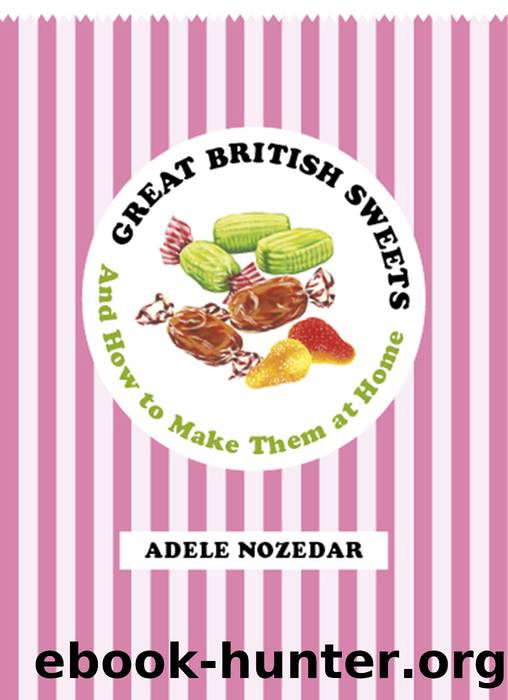Great British Sweets by Adele Nozedar

Author:Adele Nozedar
Language: eng
Format: epub
ISBN: 9781448161218
Publisher: Random House
GOBSTOPPERS
If sweets, like plants, were divided into species, then the gobstopper would belong to the genus ‘comfit’, a word which itself is derived from confectionery. A comfit is comprised of a central core – originally, perhaps, a nut – covered in a sugar coating. The sophisticated and elegant sugared almond (see here) may be the posh elderly aunt of the oafish gobstopper, but they belong to the same family.
In the USA gobstoppers are known as ‘jawbreakers’, with very good reason. They’re excruciatingly hard, and sometimes too big to get into your mouth. If you were to attempt to bite down on one this could be injurious to your pride as well as to your teeth. For some years I had a very large gobstopper, some 6–8cm across. I kept it in captivity, in a jar, all on its own. Grown-ups could never guess what it actually was; children, of course, with an instinct for sugar and more given to experimentation, knew its exact nature. Sadly, after some years, my giant gobstopper met its match in the form of a visiting old English bulldog who rolled it about with his nose and then slobbered over it for a while before he carried it away and hid it. The gobstopper has never been seen again. No doubt it’s still gathering dust and fluff under a sofa somewhere.
The gobstopper constitutes a satisfyingly sound pocket money investment for children, since they last such a long time. Some gobstoppers can last for days, if not weeks. What happens between sucks is a somewhat shady area, a private matter between the gobstopper and its owner.
The first mention we have of a gobstopper is a literary one. In 1928 Walter de la Mare, in his anthological work Come Hither, writes: ‘Gobstoppers and toffee … are these not good names for goodies?’. However, it’s a later literary invention that is credited with making the gobstopper world famous. Willie Wonka, owner of the famous Chocolate Factory, invents the ultimate sweet, the ‘everlasting gobstopper’. This kind of gobstopper never gets smaller, no matter how long you suck it. The magical sweet leapt from Roald Dahl’s page and into real life in 1976 after a company called Breaker Confections in Chicago licensed the rights to use the Willie Wonka name. Nestlé now own the brand.
We know that gobstoppers have existed for at least one hundred years, but the name of the genius who invented them is sadly lost to us. We can only wonder at how he or she stumbled on the process. A commercial gobstopper takes a while to make. A central core – perhaps one grain of sugar or the seed of a star anise – is coated with many layers of different-coloured sugar. The sweets are made in large pans which rotate and tumble the gobstopper at the same time, coating it in successive layers of differently coloured sugar. It’s a time-consuming process. Speaking of which, it is also possible to make your own gobstoppers at home, but having tried it, I would say don’t bother; it’ll drive you round the bend.
Download
This site does not store any files on its server. We only index and link to content provided by other sites. Please contact the content providers to delete copyright contents if any and email us, we'll remove relevant links or contents immediately.
Sweet by Ottolenghi Yotam & Goh Helen(2516)
Classic by Mary Berry(2501)
The Bread Bible by Rose Levy Beranbaum(2472)
Best of Jane Grigson by Jane Grigson(2468)
Flavor Flours by Alice Medrich(2339)
Sweet by Valerie Gordon(2014)
The Anne of Green Gables Cookbook by Kate Macdonald(1646)
Vegan Desserts by Hannah Kaminsky(1507)
Fabulous Party Cakes and Cupcakes by Carol Deacon(1486)
Doggy Desserts: 125 Homemade Treats for Happy, Healthy Dogs by Cheryl Gianfrancesco(1360)
Bakeland by Marit Hovland(1308)
A New Way to Bake: Classic Recipes Updated with Better-for-You Ingredients from the Modern Pantry by Editors of Martha Stewart Living(1292)
Seriously Bitter Sweet by Alice Medrich(1275)
The French Baker by Sébastien Boudet(1263)
Making Artisan Chocolates by Andrew Garrison Shotts(1231)
The Magnolia Bakery Cookbook: Old Fashioned Recipes From New Yorks Sweetest Bakery by Jennifer Appel & Allysa Torey(1212)
Teens Cook by Megan Carle(1202)
Gluten-Free Classic Snacks: 100 Recipes for the Brand-Name Treats You Love by Nicole Hunn(1186)
Baked Occasions by Matt Lewis(1166)
